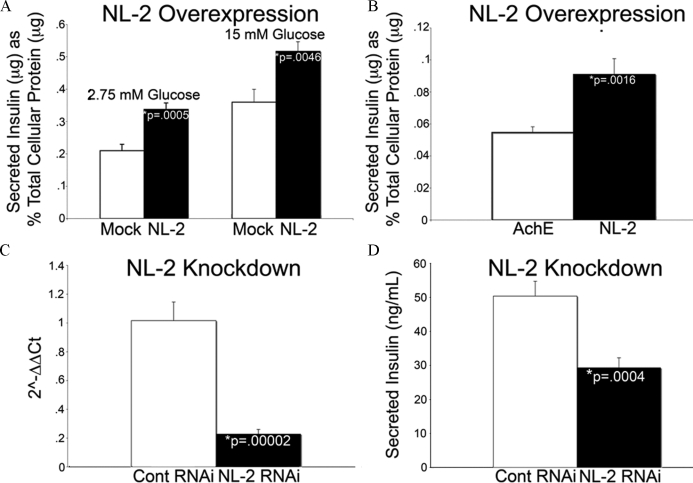Figure 7.
Overexpression and knockdown of neuroligin-2 (NL-2) alters insulin secretion in INS-1 cells. INS-1 cells were transfected with a construct encoding full-length neuroligin-2, cultured for 48 h and then conditioned for 1 h in a solution containing 2.75 mm glucose. After conditioning, secreted insulin was measured by RIA after sequential treatment with low (2.75 mm) and high (15 mm) glucose for 1 h each. Secreted insulin was normalized to total cellular protein content. A, Overexpression of neuroligin-2 increased secreted insulin levels by 61% (n = 6; P = 0.0005) and 44% (n = 6; P = 0.0046) relative to mock-transfected cells when cultured under conditions of low and high glucose. B, As a control, INS-1 cells were transfected with acetylcholinesterase (AchE), a protein that shares significant homology with the extracellular domain of neuroligin. Secreted insulin levels were measured at basal glucose levels and compared with cells transfected in parallel with neuroligin-2. A 66% increase in secreted insulin was observed in neuroligin-2-transfected cells relative to acetylcholinesterase-transfected cells (n = 12; P = 0.0016). Overexpression of neuroligins-1, -3, and -4 similarly increased basal insulin secretion (supplemental Fig. 5). C and D, INS-1 cells were transfected with either a pool of nontargeting siRNAs or a pool of siRNAs targeted to neuroligin-2, cultured for 48 h and then conditioned for 1 h in a solution containing 2.75 mm glucose. After conditioning, secreted insulin was measured by RIA after treatment with 15 mm glucose for 1 h. RNA was isolated, reverse transcribed to cDNA, and knockdown was analyzed by real-time qPCR analysis. C, Neuroligin-2 mRNA was decreased by 77% in cells treated with neuroligin-2 siRNAs relative to those treated with nontargeting siRNAs (n = 10; P = 0.00002). D, A 42% decrease in secreted insulin was observed in neuroligin-2 siRNA treated cells relative to nontargeting siRNA treated cells (n = 10; P = 0.0004).

